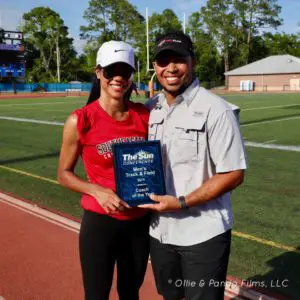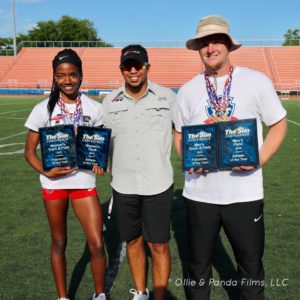Welcome to interview #119 with Coach Nicholas Dodson! Coach Nick is the head Track and Field coach at Southeastern University. The 2018-19 season was Southeastern University’s first year having a Track and Field Program, and they came in with a bang. They won both the men’s and women’s The Sun Conference titles, had fifteen individual champions, and a total of eight All-Americans.
Coach Nick was an athlete himself, being the first-ever signee at Shorter University when it started in 2006. He went on to be the NAIA National Champion in the 400m hurdles in 2011.
Now Coach Nick is eager to help the next generation of athletes, at Southeastern University and around the country. This is a must-read interview for any Track and Field athletes, or those considering an NAIA college. And, if you’re wondering whether it’s a good idea to join a young program, read on!
Introducing yourself to a coach
What can or should high school athletes do from their end to get on your radar
screen? If an athlete personally contacts you by phone or email, what will you do
next?
We have a recruiting questionnaire on our athletic page which is very
helpful. Each questionnaire comes directly to my email as my staff and I will
review it and put it into our recruiting database. We usually reach out to the
respective student-athlete within 48 hours.
I love it when athletes contact me personally by phone or email. I make sure I take out the time needed to see if
each athlete meets our team’s needs both on and off the track while also trying to
help them prepare for their next call even if they don’t fit exactly what we are
looking for. As a coach, we should want to see our young student-athletes find a
home that fits them academically and athletically.
How should a recruit prepare an introductory email that will be read by and
useful to a college coach?
They should introduce themselves with their name, where they are from,
academic performances first and then their athletic performances. I also would like to hear about what has drawn them to Southeastern other than athletics. I would love to see their email have clean grammar and correct use of punctuation.
Coaches do not want to see an email from a student-athlete that looks like they are having a conversation with one of their buddies.
Ongoing communication
After the initial email, can you talk about communication between athlete and coach moving forward?
As coaches, we know when a student-athlete is really interested in our
school and program. We will send out the steps to apply to Southeastern and
watch to see how long it takes them to apply and get everything in to have their
application completed. If they get everything done and we see they are very
interested someone on my staff or myself will reach out to our recruits at least
two to three times a month to check in on how the family is doing, how is school
going, etc. This shows our recruits that we are also interested and we care
about their well-being.
Scholarships
Could you share, in whatever detail you are comfortable with, what the athletic
scholarship breakdown looks like on your roster? How many athletes are typically
on your roster and how does this affect how much each athlete receives?
We typically recruit student-athletes who are strong academically as our
team motto is, “student-athlete and not athletic-student.” With that being said,
we look to combine additional grants with track and field scholarships (Pell Grant,
 academic scholarship, state aid, and other scholarships). This helps student-
academic scholarship, state aid, and other scholarships). This helps student-
athletes maximize all their aid as they have earned it. If you are a great student and a great athlete, then you should be rewarded for that. Being able to do that puts the student-athletes and their families in a good position to prepare for the college journey.
This season was our first year so we had about 49 total student-
athletes which is big for a first-year program. The number doesn’t affect how we give out aid as we have scholarship standards. We do not base scholarship money just off what you do athletically. We look at your academics, how you carry yourself, how you interact with your peers, athletic performances, etc. It’s bigger than just the sport for my staff and me.
How much scholarship money does the average athlete on your team receive?
It honestly just depends on the package of each student-athlete. Every
student-athlete has a different package and a different need. We just prepare
package to package.
Faith
Southeastern University is a Christian college. What should players expect from a
Christian college athletic experience?
Southeastern University is affiliated with the Assemblies of God and its Pentecostal
tradition. Here at Southeastern University (SEU) we also welcome students from all Christian backgrounds
and denominations. Our campus has Baptists, Presbyterians, Methodists, etc., as well as nondenominational students. Faculty and staff at SEU make you feel welcome and it is a positive work environment. We do have chapel and Bible study on campus with a focus on building the mind, body, and soul of the student-athletes.
Our athletic programs are successful and that is because our staff and
coaches do not give up the spiritual side for the athletic side and vice versa. We look to build our student-athletes spiritually and athletically while also striving to win championships.
Can you talk about how faith interacts and influences yourself and your athletes at Southeastern University?
We get student-athletes from many different states, countries,
environments, neighborhoods, and etc. They all have not experienced everything
life has waiting for them. Athletics teaches you a lot as adversity is involved as
well as success. My staff and I talk to our student-athletes each day about faith
but also about being consistent in your faith in order to see results. Faith is
something you can’t see, but you also can’t see oxygen but you believe you can
breathe.
First-year programs
What would you tell prospective athletes are the benefits and challenges which
await them at a first-year program like Southeastern University?
Well this year we proved a lot of people wrong and made many people
proud as we won both the men’s and women’s The Sun Conference
Championship. When you think about first-year programs I know many think
about funding, culture, staff, etc. The challenges are, everyone is new
including the staff and athletes so we have to get to know each other so that we
can prepare for the journey.
Also, know one knows about you and the program as
 you have nothing to sell in recruiting and you have to hope you are funded well enough to have a chance to be successful. The benefits are, you get to set the standard of the program and build the foundation. It later means something to you because you know you were the first.
you have nothing to sell in recruiting and you have to hope you are funded well enough to have a chance to be successful. The benefits are, you get to set the standard of the program and build the foundation. It later means something to you because you know you were the first.
Also sometimes in a first-year program that may be the only offer a student-athlete has. Sometimes all that athlete needed was a chance. It is a lot and you see both from a challenge and benefit standpoint when looking at a first-year program. No matter what, what you put in is what you get out no matter where you go. Creating a positive mind and showing a student-athlete you believe in them when probably they never really believed in themselves goes a long way. You can change a kid’s life forever.
Common Mistakes
What are a few of the most common mistakes that prospective student-athletes
make in the college recruiting process?
Not asking enough questions for sure. There is no such thing as a stupid
question and coaches commend you for reaching out and making an effort to get
the information you need. A closed mouth does not get fed.
What are some things that would keep you from recruiting an athlete?
Well, I always check the social media pages of our recruits. Sometimes kids
say, “That is not how I am.” Well, what you show people online is what they will 
take you as. Student-athletes don’t realize that your social media page is your
interview before your interview. It can determine if you will get that visit to
campus etc.
Also seeing how a student-athlete is around others and how coachable they are is important to me. Sometimes I will pop up at a practice when
the student-athlete does not know I’m in attendance. This will help me get an
accurate take on how they are with teammates, coaches, athletic trainers,
etc. This lets me know if they will fit in with what I’m building within my program.
What do you wish your incoming freshmen knew before they trained with you for the first time?
I wish they understood how much of a commitment the sport is. Most
student-athletes in our sport come from programs that didn’t take our sport
seriously. They used our sport to get ready for their primary sport. These athletes
are gifted enough to do the sport in college and then they see how much goes
into the process both academically and athletically.
Look at academics first
Bonus Question: Is there anything that you would like to share directly
with high school athletes as they navigate the recruiting process?
Look for what fits you academically first. If you have an idea of what you
want to major in, then make sure that the school has it. Do NOT pick a school just
because it satisfies you athletically as you are setting yourself up not to succeed.
Next, look for a program that has a coach and team members you feel will fit you.
This is why it is important to ask questions during the recruiting process and take
your on-campus visits very seriously. If it doesn’t fit, then it is hard to have
success. Also, remember that it is a privilege to be part of the program and
nothing is handed to you. It is work to get in, work to stay in.
To learn more about Coach Nicholas Dodson and Southeastern Track and Field, click here.
Next, check out: What is the NAIA?


